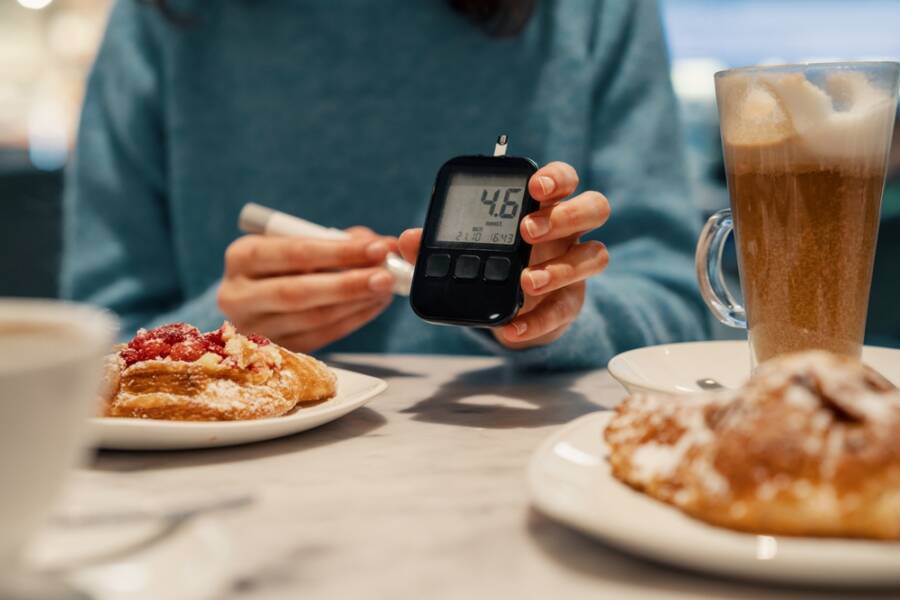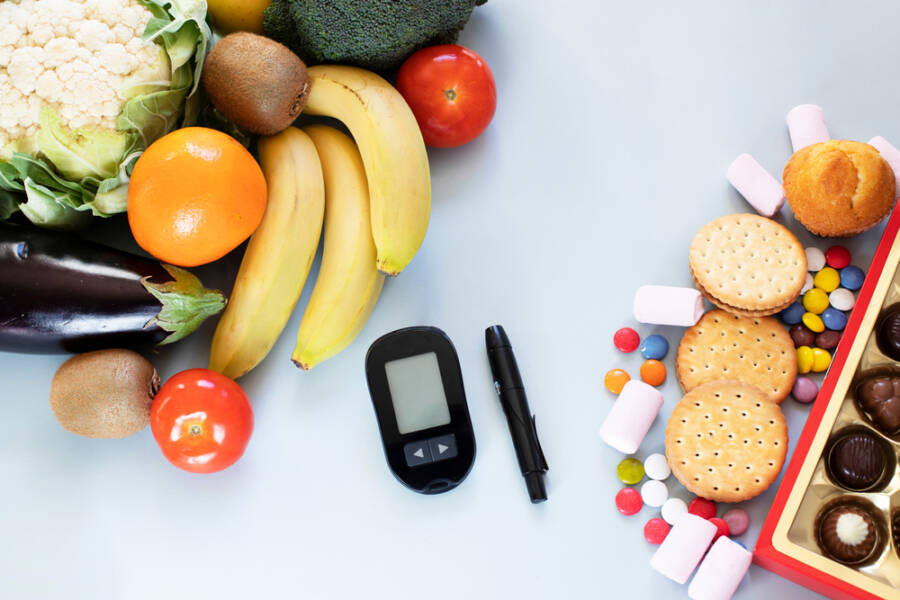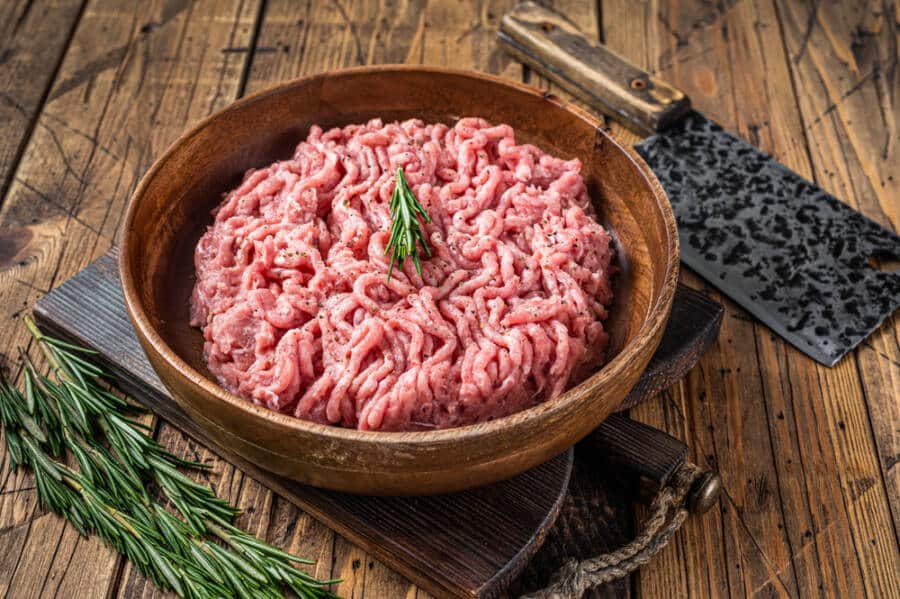Let’s talk about food intolerance in those with diabetes…
If you’re living with diabetes, you already know that a diet plan can include most foods, you may just be limited to smaller portions. And certain foods from each food group may be better than others.
So, let’s talk about some facts: Presently, nearly 11% of individuals in the US have type 1 or type 2 diabetes. And 35% of adults in our nation have prediabetes, according to the recent Dietary Guidelines for Americans.
A balanced diet can help us handle symptoms and reduce the risk of complications. But here at Indulging Health, we’re interested in finding out the connection between food intolerance and those with diabetes.
So, on that note, we did some digging and put together a guide. Continue reading to learn about symptoms, risk factors, and what to avoid.

But first…Food intolerance vs. allergies: What’s the difference?
Understanding the key difference between a food allergy and food intolerance can be tricky. Making things more confusing, the signs and symptoms of these illnesses frequently overlap. Yet, it’s important to understand that these phrases don’t describe the same problem.
And knowing what sets them apart is essential. The primary difference between a food allergy and having an intolerance is that having a food intolerance usually involves the digestive system, meaning you shouldn’t have to deal with severe symptoms.
Some individuals with food intolerances can safely eat limited amounts of the foods they’re sensitive to. On the other hand, “ACTUAL” food allergies have a significant influence on the immune system.
If someone has a food allergy, exposure to even the tiniest amount of the food they’re allergic to can result in severe or even fatal symptoms.
Causes of food intolerance in diabetics
If you have a food intolerance and are also dealing with diabetes, several different factors could be involved. They include:
-Enzyme deficiencies: To digest certain foods, you need sufficient amounts of different enzymes. Not having enough lactase, for instance, can contribute to lactose intolerance.
-Active compounds in foods like histamine: Foods rich in histamine include fermented foods, like aged cheese, sauerkraut, and red wine.
-Food additive sensitivities: Some experience digestive issues and other problems when ingesting food additives like MSG, sulfites, or coloring and preservative agents. Sulfites are used to help preserve canned goods, wine, and dried fruit and can even cause asthma attacks in certain individuals.
Common food intolerances
Following a diabetes-friendly diet is an important part of managing this condition. But food intolerances or allergies can complicate the approach of building a healthy diet that works for you.
If you’re struggling with this matter, be sure to speak to your doctor about what you can do. Some ingredients that are the most commonly linked with food intolerances include:
-Gluten
-Caffeine
-Dairy
-Fructose
-Salicylates
-Sulfites
-Amines
-Certain types of carbs called FODMAPs

Gluten intolerance and diabetes
Gluten isn’t innately toxic to those living with diabetes. But if you have type 1 diabetes, you probably also have an increased risk of celiac disease. This disorder can seriously harm a person’s intestines and prevent people from absorbing essential nutrients.
An estimated 6% of those with type 1 diabetes also live with celiac disease. In contrast, just 1% of the general population has this disorder.
Due to this, individuals with type 1 diabetes should get checked out for celiac disease when they’re diagnosed and repeat the process every 2 and 5 years.
If you feel as though you’re experiencing symptoms of celiac disease or have a first-degree family member living with this condition, your doctor may recommend additional screening.
Even though celiac disease must be treated by switching to a lifelong gluten-free diet, you can have issues consuming gluten without having full-out celiac disease. This is known as “gluten sensitivity” or “gluten intolerance.”
It shares symptoms with celiac disease but doesn’t cause any intestinal damage. Those with gluten intolerance and diabetes can still find a gluten-free diet beneficial. But you should speak to a dietician before making any major changes to your diabetes diet.
Lactose intolerance in diabetes
Nowadays, type 2 diabetes is by far the most common form of diabetes. Up to 95% of those struggling with diabetes have this variety of the condition.
But unlike type 1 diabetes, individuals can reduce their type 2 diabetes risk by making a few lifestyle changes, including watching what they eat.
A recent study of existing research concluded that consuming certain types of dairy products like yogurt and milk can lower people’s type 2 diabetes risk.
Drinking about a cup of milk was connected to a 10% reduction in risk, while eating 3.52 ounces of yogurt was associated with a 6% lower risk.
There are many drawbacks of lactose intolerance, and diabetes prevention benefits discovered in dairy can be more tricky to benefit from if you have this condition.
Nevertheless, while lactose is naturally found in milk and other dairy products, it doesn’t seem to be the source of these foods’ anti-diabetes properties. Instead, these benefits are connected to milk’s vitamins, calcium, and minerals.
Due to this, those who are lactose intolerant should be able to get similar perks from lactose-free yogurt and milk.
Symptoms of food intolerances and allergies in diabetes
Food allergy symptoms can arise minutes to hours after eating something you’re allergic to. Food intolerances can also activate a few of the symptoms listed below. But this isn’t considered a life-threatening condition.
So, the symptoms associated with food intolerances tend to be a bit milder than the ones connected to allergies. Some of the most common symptoms can include:
-Wheezing and coughing
-Rashes/flushed skin
-Hives
-An itchy or tingly feeling in the mouth
-Difficulty breathing
-Vocal cord/throat swelling
-Swelling of the tongue, lips, or face
-Abdominal cramping
-Vomiting or diarrhea
-Dizziness or lightheadedness
-Loss of consciousness
Diagnosing food intolerances in diabetes
The first thing we should mention is that you should NEVER attempt to try testing any methods on your own. Since food intolerances and allergies can cause anaphylaxis, a medical professional should always administer these tests.
If you think you may have a lactose intolerance, you can take a hydrogen breath test. It involves drinking a liquid containing lactose and breathing into a container every half hour for a few hours.
If you’re intolerant to lactose, your breath will contain high levels of hydrogen, and you may develop symptoms. Sadly, there aren’t any similar tests for food intolerances like gluten sensitivity and histamine intolerance.
Instead, you may be asked to keep a food diary to watch your food intake and note any symptoms. You could also try an elimination diet to temporarily remove particular foods from your daily diet and see how that affects you.

The bottom line: CAN diabetes cause food intolerances?
Since both food allergies and diabetes have become more and more common in recent decades, most people can’t help but wonder if and how these conditions are connected. A 2022 study explored this hypothesis by modeling diabetes and food allergies in mice populations.
This study discovered that food allergies CAN technically interact with diabetes. Of course, there are other studies focusing on the connection between the two.
For example, Type 1 diabetes seems to come with a higher rate of self-reported IgE-mediated allergy indications. Also, children with milk allergies may have an increased risk of type 1 diabetes.
That doesn’t necessarily mean the answer to “Can type 1 diabetes cause lactose intolerance?” or vice-versa is an absolute yes. But just that, there seems to be a similarity between the two conditions.
Another thing worth mentioning is that celiac disease and diabetes appear to have some similarities, which means that this intolerance could contribute to diabetes.
If you’re having trouble portioning your meals, we found this fantastic Diabetes Portion Plate with divided sections for Healthy Eating and portion control from Amazon. Who knows… it may be a huge help!
If you count yourself among those who have diabetes AND a food intolerance, please don’t hesitate to share your thoughts with us in the comments section below.
But don’t leave yet! If you found this article helpful, we highly recommend you also read: 7 Common Foods You Should NEVER Eat After 50, According to Dietitians













